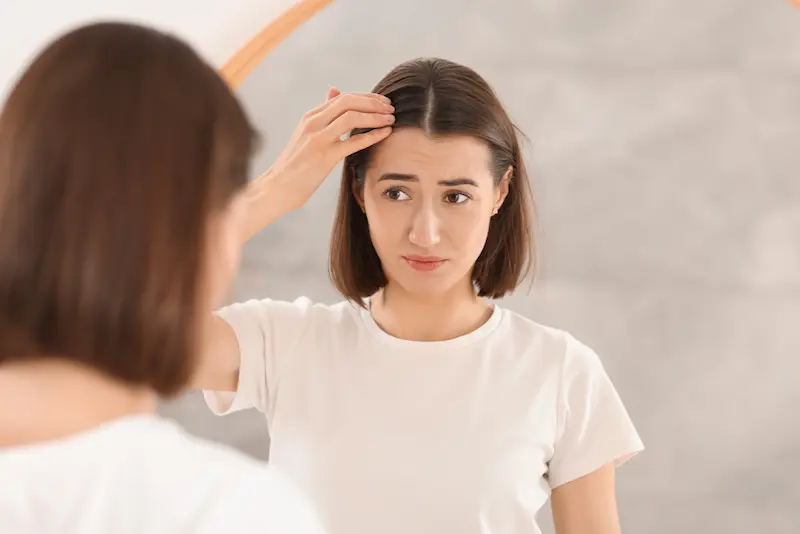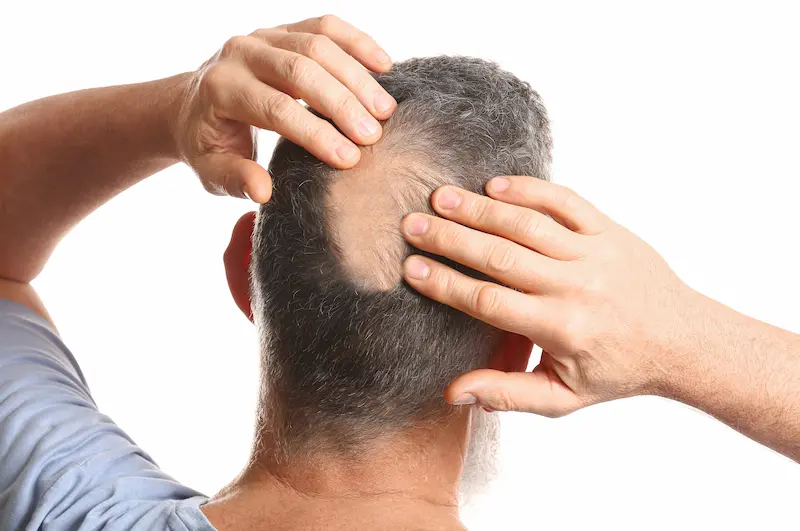Overview
Hair loss is a common issue that affects millions worldwide, impacting men and women alike. Understanding the underlying causes of hair loss is crucial for both prevention and effective treatment. Contrary to popular belief, hair loss is not merely a cosmetic concern but can reflect deeper health issues, hormonal imbalances, or genetic predispositions. This comprehensive guide delves into the root causes, highlighting distinctions between male and female hair loss, and provides insight into recognizing symptoms early, ensuring timely intervention.
Table of Contents
What Are Hair Loss Causes? Core Factors Explained
Hair loss can occur due to multiple interconnected factors. While it is normal to shed approximately 50–100 strands daily, anything beyond that could indicate an underlying condition or trigger.
Genetic Predisposition (Androgenetic Alopecia)
One of the primary and most common causes of hair loss is androgenetic alopecia, also known as hereditary or pattern hair loss. This condition manifests differently in men and women. For men, genetic hair loss typically begins with receding hairlines and thinning at the crown, potentially leading to complete baldness over time. Women, however, usually experience diffuse thinning across the scalp, maintaining their hairline. Androgenetic alopecia is associated with genetic sensitivity to dihydrotestosterone (DHT), a hormone derived from testosterone. Increased levels of DHT cause hair follicles to shrink, gradually weakening hair strands and reducing their lifespan. Identifying a genetic predisposition early on is crucial as it significantly influences treatment effectiveness.
Hormonal Imbalances & Endocrine Disorders
Hormones play a critical role in hair growth cycles, and imbalances can significantly disrupt this delicate system. Conditions like hypothyroidism or hyperthyroidism can slow down or speed up the metabolic processes related to hair growth, causing thinning or shedding. Elevated stress hormones like cortisol also contribute to hair loss by prematurely shifting hair follicles into the shedding phase. Moreover, hormonal shifts, particularly those involving estrogen and progesterone levels, commonly trigger hair loss episodes among women, particularly postpartum or during menopause. Accurate identification of hormonal imbalances requires careful diagnostic assessments, typically involving endocrinologists or dermatologists, to ensure targeted treatments and proper management.
Nutritional Deficiencies & Crash Diets
Dietary habits significantly impact hair health. Nutrient deficiencies—especially in iron, zinc, protein, vitamins D and B12, and biotin—are frequent yet overlooked contributors to hair loss. Crash diets, extreme fasting, or restrictive eating plans can rapidly deplete the body’s nutrient stores, directly weakening hair follicles and initiating extensive shedding. Iron deficiency anemia is notably prevalent among women, leading to diffused hair thinning due to insufficient oxygen delivery to follicles. Protein malnutrition similarly affects keratin synthesis, a fundamental hair-building block, resulting in brittle, fragile hair prone to falling. Addressing these nutritional issues involves dietary adjustments, targeted supplementation, and professional nutritional guidance to restore healthy hair growth.
Understanding these core factors lays the groundwork for identifying the precise causes of hair loss in both men and women. This foundational knowledge not only helps in pinpointing effective treatment strategies but also highlights the importance of comprehensive assessments and personalized hair-care regimens.
What Causes Hair Loss for Women: Female-Specific Triggers & Solutions

Hair loss in women, although less openly discussed compared to men, is incredibly common and can significantly impact emotional well-being and quality of life. While several universal factors affect hair health irrespective of gender, certain female-specific conditions and lifestyle practices notably contribute to hair thinning and shedding. Exploring these unique triggers thoroughly helps women proactively address their specific hair loss concerns, adopt timely preventive measures, and choose effective treatment paths.
Postpartum & Menopausal Hormonal Shifts
Hormonal fluctuations are among the primary reasons for female hair loss, particularly noticeable during postpartum and menopausal stages. After childbirth, many women experience postpartum hair shedding, known medically as telogen effluvium. This condition typically emerges three to six months after delivery due to sudden drops in estrogen levels. During pregnancy, elevated estrogen helps maintain hair in the growth phase (anagen), resulting in thicker and fuller hair. After childbirth, estrogen rapidly decreases, causing hair to shift quickly into the shedding phase (telogen). Though alarming, postpartum hair loss generally resolves within six to twelve months as hormone levels rebalance.
Similarly, menopause brings significant hormonal changes characterized by declining estrogen and progesterone levels. These hormonal shifts cause hair follicles to shrink, resulting in noticeably thinner and weaker hair strands. Hair thinning during menopause typically manifests gradually and may be accompanied by increased brittleness and dryness. Managing menopausal hair loss often involves hormone therapy, nutritional interventions, and topical treatments like minoxidil to stimulate follicular activity.
Polycystic Ovary Syndrome (PCOS) & Thyroid Issues
Among medical conditions frequently linked to female hair loss, Polycystic Ovary Syndrome (PCOS) and thyroid disorders are particularly prevalent.
PCOS, characterized by elevated androgen levels, affects approximately one in ten women of reproductive age. Excess androgens, such as testosterone, can accelerate hair thinning similar to male-pattern baldness, especially around the crown or frontal hairline. Alongside hair loss, women with PCOS may also experience excessive hair growth on the face or body, irregular menstrual cycles, and difficulty maintaining a healthy weight. Addressing hair loss due to PCOS usually involves treating the hormonal imbalance through medications like birth control pills or anti-androgen drugs.
Thyroid disorders—both hypothyroidism (underactive thyroid) and hyperthyroidism (overactive thyroid)—significantly impact hair health. An underactive thyroid reduces metabolic function, slowing down follicular activity, and causing brittle, thinning hair. Conversely, hyperthyroidism accelerates metabolism excessively, often resulting in diffuse hair shedding. Thorough thyroid screening, including TSH and T4 tests, helps pinpoint the precise disorder, allowing targeted hormonal treatments to effectively manage associated hair loss.
Styling Practices, Chemical Treatments & Traction
Lifestyle factors, including frequent chemical treatments, excessive heat styling, and hairstyles causing constant tension, also contribute significantly to female hair loss. Traction alopecia—hair loss resulting from prolonged tight hairstyles such as ponytails, braids, or extensions—can permanently damage hair follicles if left unchecked. Chemical processes like bleaching, perming, or straightening weaken hair strands and scalp health, leading to breakage and increased shedding.
Minimizing hair loss from styling practices involves adopting gentle hair-care routines, reducing the frequency of chemical treatments, and using protective, nourishing products. Regularly alternating hairstyles to relieve follicular stress and incorporating hair-strengthening treatments like deep-conditioning masks or serums enriched with essential nutrients can significantly mitigate styling-induced hair damage.
Addressing these female-specific hair loss triggers requires awareness and proactive measures, combining medical evaluation, lifestyle adjustments, and targeted therapeutic solutions. By understanding precisely what causes hair loss for women, individuals can make informed decisions, preserving both hair health and self-confidence.
What Causes Hair Loss for Men: Major Triggers & Treatments

Hair loss is notably prevalent among men, often beginning early and progressing steadily throughout adulthood. Although widely accepted as a common occurrence, understanding precisely what causes hair loss for men is vital. Recognizing the root causes can lead to early intervention and more effective treatment outcomes. Male hair loss frequently stems from genetic factors, hormone sensitivities, lifestyle issues, and autoimmune conditions. Below, we thoroughly examine these major triggers, along with appropriate therapeutic interventions.
Why Hair Loss for Men Often Begins Early: DHT & Genetic Sensitivity
Male pattern baldness, medically termed androgenetic alopecia, remains the most common form of hair loss among men. Genetic sensitivity to the androgen hormone dihydrotestosterone (DHT) predominantly drives this condition. DHT is a potent derivative of testosterone that binds to hair follicle receptors, shrinking them and reducing their ability to produce robust, healthy hair strands. Men genetically predisposed to high DHT sensitivity experience hair thinning progressively, typically starting at the temples or crown. Eventually, this can advance to extensive baldness if not managed appropriately.
Early onset, often observable in men’s late teens or early twenties, significantly impacts self-esteem and social confidence. Effective treatments include medications such as Finasteride and Minoxidil, which inhibit DHT production or stimulate hair follicle activity, respectively. Proactively addressing DHT-related hair loss through early intervention typically provides the best long-term results, slowing progression and encouraging healthier regrowth.
Stress, Telogen Effluvium & Lifestyle Factors
Lifestyle choices and stress levels significantly contribute to male hair loss. Chronic stress can trigger Telogen Effluvium—a condition where hair prematurely enters the shedding (telogen) phase. While stress-induced hair loss is usually temporary and reversible, chronic stress and inadequate management may prolong shedding episodes or intensify their severity. Stress management strategies such as mindfulness, meditation, and exercise routines can considerably mitigate stress-induced hair loss.
Additionally, lifestyle factors such as smoking, poor dietary habits, and lack of regular physical activity negatively impact hair growth cycles. Tobacco use reduces blood circulation to hair follicles, limiting nutrient delivery and oxygen supply necessary for healthy hair growth. Similarly, diets lacking essential vitamins and minerals (like iron, zinc, vitamin D, and biotin) contribute to weaker, brittle hair strands prone to premature shedding. Men experiencing hair loss should prioritize balanced nutrition, targeted supplementation, and healthy lifestyle adjustments for lasting improvement in hair density and overall health.
Autoimmune Conditions Such as Alopecia Areata
Autoimmune-related hair loss, specifically Alopecia Areata, affects men by creating sudden, patchy bald areas across the scalp. In this autoimmune condition, the body mistakenly identifies hair follicles as foreign invaders and attacks them, interrupting normal hair growth cycles. The resulting bald patches, typically smooth and circular, can appear rapidly and unpredictably.
Although Alopecia Areata can spontaneously resolve, recurrent episodes or severe forms may require treatment interventions. Common therapeutic approaches include corticosteroid injections directly into affected scalp areas, topical immunotherapy, and newer biological treatments targeting underlying immune dysregulation. Early diagnosis through dermatological assessment significantly improves prognosis, limiting long-term follicular damage and enhancing hair regrowth prospects.
Clearly identifying and understanding what causes hair loss for men enables more effective preventive strategies and tailored therapeutic interventions. By addressing these factors early—genetic sensitivity, lifestyle habits, stress management, and autoimmune triggers—men can better maintain hair health, slowing or reversing hair loss progression, and achieving sustainable hair restoration outcomes.
Diagnosing the Causes of Hair Loss: Tests, Screening & Consultation
Accurate diagnosis is the cornerstone of effectively addressing the various causes of hair loss. Regardless of gender or underlying reasons, identifying the specific triggers responsible for hair loss is crucial to determining optimal treatment pathways. Professional diagnosis typically involves a detailed medical consultation, physical scalp examination, and specialized diagnostic tests to evaluate the hair and scalp condition comprehensively. Understanding these diagnostic methods helps individuals proactively approach hair loss issues, facilitating timely interventions and effective management.
Trichoscopy & Detailed Scalp Analysis
Trichoscopy, a non-invasive diagnostic tool, is an essential first step in evaluating hair loss. Utilizing advanced digital imaging technology, trichoscopy provides magnified visual inspection of hair shafts, follicles, and scalp condition. Specialists, typically dermatologists or trichologists, examine key indicators such as follicle density, scalp inflammation, hair shaft thickness, and the presence of broken hairs or miniaturized follicles characteristic of androgenetic alopecia.
This detailed scalp analysis helps precisely identify hair loss patterns and distinguish between various conditions such as alopecia areata, androgenetic alopecia, traction alopecia, or scalp infections. Trichoscopic evaluations are painless and provide rapid, highly accurate results, guiding subsequent diagnostic and therapeutic steps efficiently.
Blood Tests for Hormonal & Nutrient Levels
Comprehensive blood screening is essential for accurately pinpointing internal contributors to hair loss. Blood tests typically measure crucial hormones and nutrients influencing hair growth, including:
- Thyroid Function Tests (TSH, T3, T4): These evaluate the thyroid gland’s activity, pinpointing hypothyroidism or hyperthyroidism, both significant causes of hair thinning or shedding.
- Hormonal Profile: Including assessments of testosterone, DHT, estrogen, progesterone, prolactin, and cortisol levels, these tests clarify hormonal imbalances that frequently trigger hair loss, particularly androgenetic alopecia and hormonal disorders like PCOS.
- Nutrient Deficiency Screening: Tests for iron, ferritin, vitamin B12, vitamin D, zinc, and biotin levels identify dietary deficiencies directly affecting hair health. Iron deficiency anemia, for instance, is a frequent cause of diffuse hair shedding, particularly among women.
Based on these results, practitioners formulate personalized treatment plans, often combining hormonal therapies, dietary adjustments, and targeted supplementation.
Biopsy & Microscopic Examination
In some cases, especially when hair loss diagnosis is uncertain, scalp biopsies may be necessary. A scalp biopsy involves extracting a small tissue sample from the scalp for microscopic evaluation. While invasive, biopsies offer definitive diagnosis in ambiguous or complex cases, identifying subtle histological changes characteristic of certain hair loss conditions.
Microscopic examination evaluates follicular structures, assessing signs of inflammation, scarring, follicular destruction, or autoimmune activity indicative of conditions such as lichen planopilaris or scarring alopecia. Biopsy results provide clear, precise guidance for treatment, particularly when clinical diagnosis alone is inconclusive.
By utilizing advanced diagnostic tools—trichoscopy, hormonal and nutrient blood tests, and scalp biopsies—patients can receive accurate, timely diagnoses of the precise causes of hair loss. Professional consultation combined with thorough diagnostics significantly enhances treatment effectiveness, promoting sustainable hair health and improving overall patient outcomes.
Preventive Strategies & Treatment Pathways
Addressing hair loss effectively requires a combination of preventive measures, medical treatments, and, in some cases, advanced surgical solutions. Understanding these treatment pathways is essential once the underlying causes of hair loss have been accurately diagnosed. A proactive approach, combining lifestyle adjustments, medical therapies, advanced regenerative methods, and surgical solutions, significantly enhances the likelihood of successfully managing hair loss and promoting sustainable regrowth.
Medical Therapies (Minoxidil, Finasteride, PRP)
Medical treatments form the frontline strategy in managing hair loss, particularly in androgenetic alopecia and other hormone-driven conditions.
- Minoxidil: Approved by the FDA, minoxidil is a topical solution or foam applied directly to the scalp. It works by increasing blood flow to hair follicles, stimulating them and prolonging the hair growth phase. Minoxidil is effective for both men and women and shows results within 3–6 months of consistent use.
- Finasteride: Primarily prescribed for men, finasteride effectively treats androgenetic alopecia by blocking the conversion of testosterone into DHT. It significantly slows or halts hair thinning, particularly when treatment begins early. While highly effective, finasteride requires ongoing use to maintain results.
- Platelet-Rich Plasma (PRP): PRP is an innovative therapy using the patient’s own blood plasma, rich in growth factors. PRP injections into the scalp promote hair follicle regeneration, reduce inflammation, and improve follicular health. Regular sessions are typically needed to sustain improvements in hair density and thickness.
Advanced Options (Low-Level Laser Therapy, Exosomes)
Emerging regenerative treatments offer promising alternatives or complements to conventional medical therapies:
- Low-Level Laser Therapy (LLLT): This painless, non-invasive treatment uses low-level laser devices to stimulate cellular metabolism and follicular regeneration. By enhancing circulation and energy metabolism in follicles, LLLT promotes thicker, healthier hair growth. Suitable for men and women, consistent use over several months typically yields noticeable improvement.
- Exosome Therapy: An innovative regenerative treatment, exosomes are extracellular vesicles containing growth factors and regenerative proteins derived from stem cells. Exosome therapy significantly boosts hair follicle repair and regeneration, stimulating dormant follicles and encouraging robust hair growth. This therapy is particularly beneficial for patients experiencing thinning unresponsive to traditional medical treatments.
Surgical Solutions & Hair Transplant Considerations
When medical or regenerative therapies fail to deliver sufficient results, surgical hair restoration remains a reliable and permanent solution for hair loss.
- Follicular Unit Extraction (FUE): Currently the most popular hair transplant technique, FUE involves harvesting individual hair follicles from donor areas (typically the back or sides of the scalp) and transplanting them to bald or thinning areas. FUE is minimally invasive, leaving minimal scarring and delivering natural-looking results.
- Sapphire FUE and Ice Sapphire FUE: Enhanced versions of traditional FUE, these methods employ precision sapphire blades and ice cooling techniques to reduce trauma and accelerate healing, yielding superior aesthetic outcomes. — Sapphire FUE – Ice Sapphire FUE
- FUT (Follicular Unit Transplantation): Though less commonly used today, FUT involves harvesting a strip of scalp from donor regions, dissecting it into individual follicular units, and transplanting them to recipient areas. FUT may suit specific patients requiring large graft numbers.
Surgical intervention demands careful patient evaluation, realistic expectations, and post-operative commitment to ensure successful, satisfying outcomes.
By integrating preventive lifestyle changes, adopting targeted medical and regenerative treatments, and strategically employing surgical methods, individuals experiencing hair loss can achieve optimal and lasting results. Proactively understanding and addressing the underlying causes of hair loss paves the way for comprehensive management, restoring not just hair, but also confidence and quality of life.


